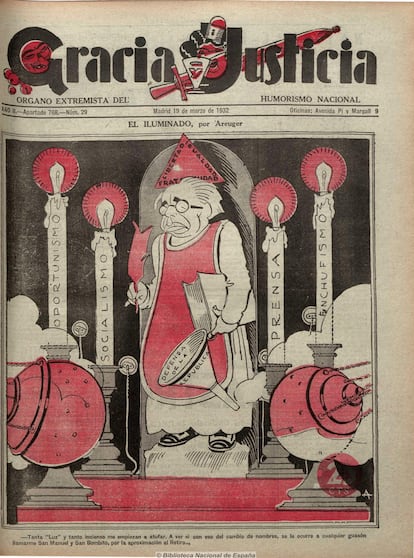The phrase “The Judeo-Masonic Conspiracy” was a song of Franco’s rhetoric with which Machamartillo identified some of the enemies of Spain. However, how did that bond of Jews and Masons arise with evil? Less than two months after 50 years after the death of the dictator Francisco Franco, an exhibition at the Sefarad-Israel Center, in Madrid, travels through the history of persecution to both groups, with emphasis on the Spanish case, and gives the keys to the origin of this expression in the Francoist imaginary.
The sample, entitled The Judeo-Masonic conspiracy. The construction of a mythdates back to the fourth century, “when the first Jewish communities were settled in Spain and its members were contemplated with suspicion by the Spanish-Visigoda population,” the Commissioner of the Exhibition, Leandro Álvarez Rey, professor of contemporary history at the University of Seville, writes in the catalog.
Through panels, audiovisuals, objects, books, documents, posters, newspapers and magazines, mainly from the Documentary Center of Historical Memory, in Salamanca; Of private collections and the National Library, the exhibition, until March 31, 2026, gives an account of the vision of the Jew as recurring scapegoat in Spanish and European history. In addition to the Sepharad Center, the Secretary of State for Democratic Memory, of the Ministry of Territorial Policy and Democratic Memory, and the Ministry of Foreign Affairs, European Union and Cooperation.
Returning to Visigothic Spain, anti -Jews laws were approved to propitiate forced conversions. “It was one of the worst eras because the Visigoths were adopting Christianity,” explains Álvarez Rey on the phone. After the Muslim invasion, “the situation of the Jews improved, although they were obliged to pay extraordinary taxes.” In parallel, in the Christian kingdoms they performed an important economic role until the terrible year of 1391, when in successive waves “the Jewish neighborhoods of the main cities of Castile and Aragon were assaulted and looted.”
Both in the Peninsula and in Europe, popular legends spread anti -Semitism until the judicial instances permeate. The “Blood Libelos” were processes against Jews in which they were accused of obtaining blood from Christians for their rituals. On other occasions they were prosecuted for killing children. Thus, the legend of the mid -thirteenth century of the Dominguito del Val, from Zaragoza is remembered in the exhibition, to which a Jew would have kidnapped to crucify him. Two centuries later the story was repeated with another child, Juan Pasamontes, kidnapped and killed by a group of Jews in Toledo, said. A 1491 case that motivated several executions, although the child’s body was not found nor had its existence been tested.
However, the most painful for this group was yet: the expulsion of 1492 issued by the Catholic Monarchs, except for those who accept the conversion. It was the diaspora of the Sephardic in Europe, North Africa and the Ottoman Empire. Those who stayed became Judeoconversosos or “new Christians” and objects of persecutions to find out if they continued to secretly practice Judaism.
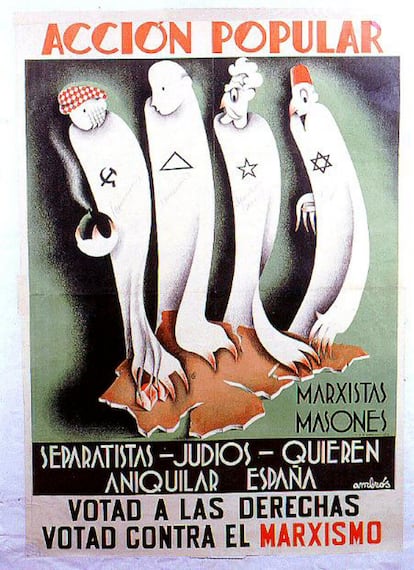
The racist nationalisms that emerged in Europe in the 19th century renewed anti -Semitism, as happened in France with the famous Case Dreyfusin which a captain of the French army, of Jewish origin, was sentenced to life imprisonment for considering a spy of the Germans. Although, months later, it was shown that it had been a mistake, he continued in prison. It was not rehabilitated up to 12 years later.
Together with the Jews, who was accused of aspiring to dominate the world, he got into the same bag to Masonry, a new calamity. Organized in secret brotherhoods, he was born at the beginning of the XVIII in England “as a philanthropic organization that defended freedom, equality, tolerance and was based on reason,” is counted on a panel. The myth of “the Judeo-Masonic conspiracy”, which would feed the Francoism, was formed at the end of that century, when the French Revolution was linked. In Spain, the Catholic Church was especially belligerent against them, writes in the José-Leonardo Ruiz Sánchez catalog, professor of contemporary history of the University of Seville.
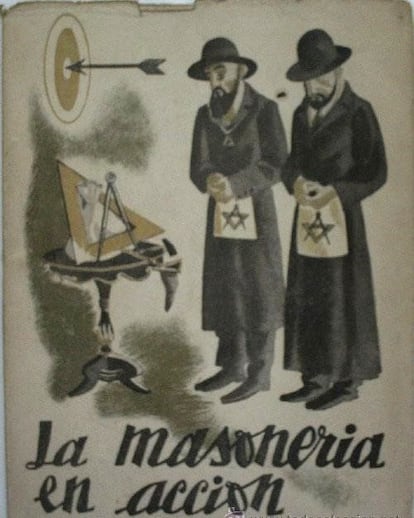
At the beginning of the XX this current was favored by pamphlets such as Protocols of the Sages of Zionor the one who wrote the Magnate of Henry Ford motor racing, entitled The international Jew.
The Spanish masons tried to influence politics with the defense of freeing and secularization of society, so there were in their socialist and anarchist ranks. Their opposition to clericalism and their affinity to republicanism won hatred. In those years another enemy is added, communism, which had triumphed with the Russian revolution in 1917. Jews, communists and Masons, together with separatism, became the anti-Spanish to eliminate by the rebels in 1936. Precisely, of that time there are electoral posters of the Catholic Party Popular Action with this message: “Marxists, Masons, separatists, Jews.
It is also underlines that during the Second Republic “there were presidents of the Government, ministers and senior Masons positions.” There is the figure that, in the constituent courts of 1931, of 470 deputies, 150 were or had been. However, in 1936 the Masons added only about 5,000 throughout the country, and as for the Jews it is pointed out that there were 6,000.
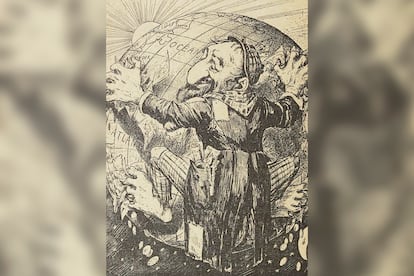
There were characters who stood out in this gate, such as Father Tusquets, son of banker, who published with great success Origins of the Spanish Revolution (1932). “There are the ingredients of what will later be the idea of the Judeo-Masonic conspiracy in Franco,” adds the commissioner.
About to end the war, the Ministry of Education approved that in schools the Spanish patriotic catechismin which it was proclaimed that Freemasonry was “a secret society, ally of Judaism, to perform its criminal attempts in the shadow.” Franco himself, in his speech of the Victoria Parade, on May 19, 1939, warned: “The Jewish spirit that allowed the alliance of the great capital with Marxism (…) does not be removed in one day.”
In March 1940, the law of repression of Freemasonry and communism was approved, whose preamble said: “No factor, among the many that have contributed to the decline of Spain, influenced so perniciously (…) as the secret societies of every order.” The instrument to apply it was a special court, which worked until 1964. Álvarez Rey points out that his documentation generated about 65,000 summaries.
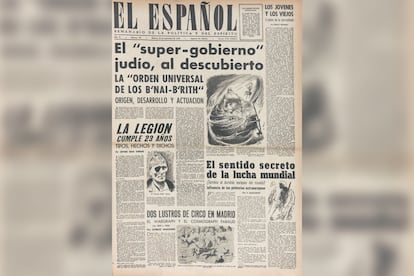
Why was Franco Antimason? “There are several theories. The truth is that he was an avid reader of a plot literature.” The historian also points out a family rejection factor: “His father was a member of a society of freethinkers and his brother Ramón (aviator), who at first was much better known than him, entered Masonry.”
After the Nazi defeat in World War II, Francoism abandoned the Anti -Jewish propaganda, especially as the horrors of the extermination fields. However, Franco, with Jakim Boor’s pseudonym, published in the Falangista newspaper Abovebetween 1946 and 1951, several articles in which he maintained the anti -Semitic tone.
On October 1, 1975, just over a month for his death, Franco, in his last speech from the Plaza de Oriente, in Madrid, maintained his verbiage after the protests in other countries against his dictatorship, which were due “to a leftist Masonic conspiracy in the political class in Contubernio with the communist-terrorist subversion”.
What remains in Spain today of that aversion to Jews and Masons? “There are still sectors that indicate conspiracy plans because it is easier to explain the problems based on a secret plan than to understand the real reasons,” says Álvarez Rey. On whether what Israel is committing in Gaza can spur anti -Semitism, believe “that people know how to distinguish between a people and what their government does.”

